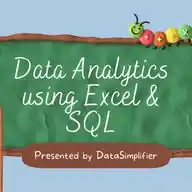
Excel For Data Analytics
May 25, 2025 at 07:45 PM
*Excel Interview Questions and Answers – Part 4:*
*19) Explain the purpose of the "What-If Analysis" tools in Excel.*
Answer:
What-If Analysis helps explore different scenarios and outcomes by changing input values.
There are 3 main tools in Excel:
- Scenario Manager: Create and switch between different sets of values to see how they affect results.
- Goal Seek: Finds the input value needed to reach a specific output.
Example: What sales value is needed to reach $10,000 profit?
- Data Table: Shows how changing one or two variables impacts the result.
*20) What are array formulas, and can you provide an example of their use?*
Answer:
Array formulas perform multiple calculations on one or more items in an array.
They can return a single value or multiple values.
Example (old-style, press Ctrl+Shift+Enter):
=SUM(A1:A5*B1:B5) – Multiplies each pair and then sums the results.
Modern Excel (dynamic arrays):
=FILTER(A2:A10, B2:B10="Completed") – Returns only rows where status is "Completed".
*Business Analysis Specific Questions*
*1) How would you analyze a set of sales data to identify trends and insights?*
Answer:
- Use PivotTables to group by month, region, or product.
- Apply Conditional Formatting to highlight top performers.
- Create line charts for trend analysis.
- Use AVERAGE, MEDIAN, and STDEV functions for deeper insights.
- Add calculated columns (e.g., YoY growth or percent change).
*2) Explain how you might use Excel to perform financial modeling.*
Answer:
Financial modeling in Excel includes:
- Forecasting income, expenses, and cash flow
- Linking assumptions, inputs, and outputs via formulas
- Using functions like NPV, IRR, PMT, and XNPV
- Creating interactive dashboards or reports with charts and slicers
- Scenario analysis with data tables and goal seek
*3) What Excel features would you use for forecasting and budgeting?*
Answer:
FORECAST.LINEAR() or built-in Forecast Sheet
Data tables for scenario modeling
PivotTables for historical trends
Goal Seek to backtrack target metrics
Use Named Ranges and structured tables for dynamic models
*4) How do you handle large datasets in Excel, and what tools or techniques do you use for optimization?*
Answer:
- Convert data into Excel Tables
- Use Power Query to clean and transform data
- Avoid volatile functions like OFFSET and INDIRECT
- Minimize use of complex array formulas
- Use filters, PivotTables, and efficient formulas like INDEX-MATCH instead of VLOOKUP
*React ❤️ if this helped you*
❤️
❤
👍
♥
💍
💚
🙈
🙏
31